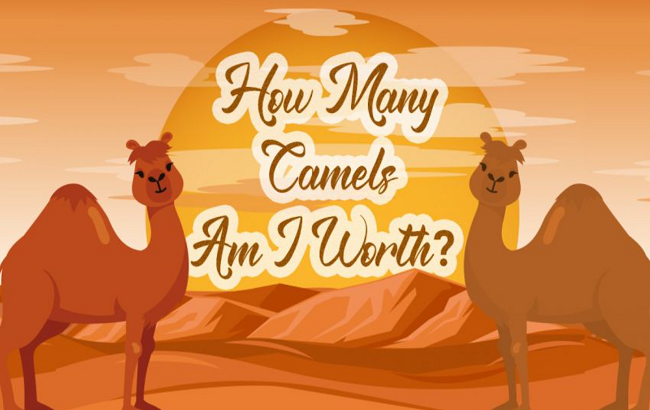Have you ever wondered “How many camels am I worth?”? While it might seem like an unusual or even funny question, it actually has deep cultural and historical significance. This phrase is commonly associated with the concept of dowries and bride prices in certain regions, particularly in the Middle East, North Africa, and parts of South Asia. In this article, we will uncover five shocking truths about the phrase, its origins, and how its meaning has evolved over time. By the end, you’ll understand the complexities behind “How many camels am I worth?” and why it continues to provoke curiosity today.
1. The Historical Value of Camels and Their Cultural Significance
In many ancient cultures, camels were much more than just animals—they were vital to survival and represented wealth, status, and resilience. In regions like the Middle East and North Africa, where the environment is harsh and desert-dwelling nomads depended on camels for transportation, food, and trade, these animals became deeply woven into the fabric of everyday life.
Camels as Symbols of Wealth and Survival
In these societies, camels were considered a symbol of prosperity. A camel could be worth its weight in gold due to the following reasons:
- Transport: In regions where roads were scarce or non-existent, camels provided an essential means of transport, carrying goods across vast deserts.
- Food and Water: Camels are known as the “ships of the desert” because they can survive without water for extended periods. They were also used for milk and meat, providing sustenance to nomadic tribes.
- Economic Assets: Camels were not only used for practical purposes; they became an asset that could be traded. A large herd could represent a family’s wealth and influence.
For many societies, the more camels you owned, the higher your status. This made camels an important commodity in the exchange of goods, including marriage agreements.
Camels in Dowries and Bride Prices
The concept of “How many camels am I worth?” has its roots in the dowry system. In ancient times, when marriages were arranged, camels were often exchanged between families as part of the bride price. The number of camels a bride could bring to a marriage often reflected her status, family background, and the wealth of her family.
- The Dowry System: A dowry is a transfer of wealth from the bride’s family to the groom’s family, usually in the form of goods, land, or livestock. In many desert societies, camels were the preferred item in these dowries.
- Bride Price: The exchange of camels, known as a bride price, was a way of ensuring the bride’s security within her new family. It also represented her value and the responsibility placed on the groom’s family to provide for her.
The number of camels could vary depending on factors like the bride’s family status, her beauty, or the political and economic circumstances at the time.
Key takeaway: In historical societies, camels were highly valued for their practicality and symbolized wealth. As a result, they became part of the dowry system, often determining a person’s worth in marriage.
2. The Evolution of the Phrase in Modern Times
As societies evolved, so did the meaning and significance of “How many camels am I worth?” The practice of using camels in dowries has mostly disappeared, yet the phrase remains an intriguing part of popular culture and conversation.
Transition from Dowries to Pop Culture
Today, when someone asks “How many camels am I worth?” it’s typically a rhetorical or humorous question. The phrase has transcended its original context and is often used in light-hearted discussions, usually as a way to compliment or tease someone. Here are some examples:
- Pop Culture: The phrase has been used in movies, TV shows, and literature, often in a playful or exaggerated manner to highlight a character’s value or self-worth.
- Social Media: On social platforms, you might find memes or posts that ask, “How many camels am I worth?” in a funny or sarcastic context, often in response to a compliment or a statement about someone’s appearance.
This shift from a serious practice to a joke is a testament to how cultural norms change over time. Today, it’s no longer a matter of assigning value through camels but rather a fun way to discuss someone’s worth or appeal.
The Continued Use of Camels in Certain Cultures
While the practice of using camels in dowries may have faded in many places, it still exists in certain rural and traditional communities. In some parts of the world, the tradition of paying a bride price with camels remains alive.
- Bedouin and Nomadic Communities: In places like Sudan, Somalia, and parts of Saudi Arabia, camels are still used in marriage arrangements. They may not be exchanged as frequently as before, but they still play a role in expressing the bride’s worth.
- Camel Auctions and Breeding: Today, camels are still highly prized in some regions. Camel racing is a lucrative industry, and camels are often bred and sold for high prices. This gives them continued economic importance and reflects their lasting status as valuable assets.
Key takeaway: While camels may no longer be a primary method of exchanging dowries, they still hold value in some societies. Meanwhile, the phrase “How many camels am I worth?” has transformed into a humorous, lighthearted question in modern times.
3. The Debate: Is Asking How Many Camels Am I Worth Offensive or Empowering?
The question “How many camels am I worth?” can be interpreted in many ways, and whether it’s seen as offensive or empowering depends on context and perspective.
The Objectification Argument
Critics argue that asking this question, even in jest, can be harmful because it reduces a person, especially women, to their material worth. Here’s why some view the phrase as problematic:
- Historical Context of Objectification: In societies where camels were exchanged for women, the practice was often tied to patriarchal structures where women were treated as property or commodities.
- Modern Relevance: In the modern world, we have made significant strides toward gender equality. Asking how many camels someone is worth may be seen as reinforcing outdated and objectifying views of women.
However, it’s important to note that the use of this phrase today is typically meant in a light, non-serious manner. In many cases, it’s simply a way of joking about self-worth or self-esteem.
Empowering Through Humor
On the flip side, some people find the phrase empowering because it can be seen as a way to reclaim the idea of personal worth in a playful way. When used humorously, it can serve to express confidence or self-assurance. Here’s how:
- Confidence Boost: For some, asking “How many camels am I worth?” is a way to affirm their own value or beauty. It can be a humorous way to acknowledge one’s self-worth without taking things too seriously.
- Reclaiming Ownership: By making the phrase lighthearted, it allows people to regain control over how their worth is perceived, in contrast to how it was historically measured.
Key takeaway: Whether offensive or empowering, the phrase depends on context and intent. Used humorously, it can be a fun way to discuss personal value in modern times.
4. The Economic and Cultural Relevance of Camels Today
Even in today’s world, camels continue to play an important role in some economies. They are still valuable assets in many parts of the world, contributing to agriculture, tourism, and racing industries.
Camels in Agriculture
In countries like Saudi Arabia, camels are still used for farming purposes. They provide:
- Milk: Camel milk is a nutritious beverage in many cultures and is seen as a remedy for various ailments.
- Meat: Camel meat is consumed in some regions, particularly in the Middle East.
- Transport: In rural areas, camels are still used for transporting goods across difficult terrains.
Camels in Tourism and Racing
- Camel Trekking: In places like Morocco and Egypt, camel trekking has become a popular tourist attraction. Visitors pay to ride camels through desert landscapes, creating a significant income for local communities.
- Camel Racing: The sport of camel racing, particularly in the UAE and Saudi Arabia, is a multimillion-dollar industry. Prize camels are worth millions, and breeding and training camels for races can be extremely profitable.
Key takeaway: While camels are no longer used in dowries, they remain valuable for their economic and cultural contributions, particularly in agriculture and tourism.
5. Why You Shouldn’t Take the Phrase Literally
In today’s world, asking “How many camels am I worth?” is rarely about actual camels or material value. Instead, it’s typically a rhetorical question that reflects how people perceive their worth in a fun or playful way.
Self-Worth in Modern Society
In today’s society, a person’s value is determined by much more than material goods or livestock. Personal qualities such as kindness, intelligence, creativity, and generosity define true worth.
- True Value: Your worth isn’t about the number of camels you might bring to a marriage; it’s about who you are as a person and how you treat others.
- Materialism vs. Character: Modern discussions of value tend to focus on character traits rather than material possessions, making the idea of measuring someone’s worth with camels outdated and irrelevant.
Humorous or Self-Reflective?
In most cases today, when someone asks, “How many camels am I worth?” they’re simply using humor to reflect on their own worth or making a playful comment about their appearance. It’s more about self-esteem than anything else.
Key takeaway: Don’t take the phrase literally. In modern contexts, it’s more about playful banter than anything to do with camels or material wealth.
Frequently Asked Questions (FAQ)
1. Is the phrase “How many camels am I worth?” offensive?
It depends on context. When used in a playful manner, it’s generally not offensive. However, it can be seen as objectifying if used inappropriately.
2. Why did camels become a measure of worth?
Camels were incredibly valuable assets in desert regions due to their practical uses in transport, food, and trade.
3. Do camels still hold economic value today?
Yes, camels are still valuable in agriculture, tourism, and racing industries, particularly in the Middle East and North Africa.
4. Why do people still use the phrase today?
The phrase is mostly used humorously or rhetorically to discuss self-worth or beauty in a lighthearted manner.
5. Can the phrase “How many camels am I worth?” be empowering?
Yes, when used humorously, the phrase can be a way for people to express confidence and self-assurance.
Conclusion
The phrase How many camels am I worth? has a rich history rooted in ancient cultures and the dowry system. While its meaning has evolved over time, it continues to provoke interest and discussion, often in a playful or rhetorical way. Whether used to reflect on one’s value, discuss cultural practices, or simply as a humorous conversation starter, the question of camels remains a fascinating topic. To learn more about another intriguing family dynamic, check out this outline for Chrisley Knows Best daughter.
You May Also Like:





